The Amityville Horror Blu-ray Movie
HomeThe Amityville Horror Blu-ray Movie 
Metro-Goldwyn-Mayer | 1979 | 119 min | Rated R | Oct 07, 2008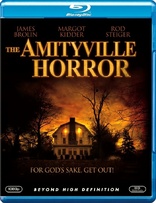
Movie rating
6.6 | / 10 |
Blu-ray rating
| Users | 3.9 | |
| Reviewer | 2.0 | |
| Overall | 3.5 |
Overview
The Amityville Horror (1979)
George and Kathy Lutz, a newly married couple with three children from Kathy's previous marriage, purchase a large house in Amityville, New York, where a multiple murder took place the year before. Strange things happen as soon as they move in. Father Delaney, Kathy's friend and priest, is stricken ill when he tries to bless the house, and he becomes convinced that Kathy and her family are in danger. The policeman who investigated the original murders notices an odd resemblance between George Lutz and the man convicted of those crimes. Based on a true story.
Starring: James Brolin, Margot Kidder, Rod Steiger, Don Stroud, Murray HamiltonDirector: Stuart Rosenberg
| Horror | Uncertain |
| Thriller | Uncertain |
| Supernatural | Uncertain |
| Mystery | Uncertain |
| Psychological thriller | Uncertain |
Specifications
Video
Video codec: MPEG-4 AVC
Video resolution: 1080p
Aspect ratio: 1.85:1
Original aspect ratio: 1.85:1
Audio
English: DTS-HD Master Audio 5.1 (48kHz, 24-bit)
English: Dolby Digital 5.1 (448 kbps)
English: Dolby Digital 2.0 Mono (224 kbps)
French: Dolby Digital 5.1 (448 kbps)
Spanish: Dolby Digital 5.1
Subtitles
English, Spanish, Cantonese, Korean
Discs
25GB Blu-ray Disc
Single disc (1 BD)
Playback
Region A (locked)
Review
Rating summary
| Movie | 1.0 | |
| Video | 3.5 | |
| Audio | 4.0 | |
| Extras | 0.0 | |
| Overall | 2.0 |
The Amityville Horror Blu-ray Movie Review
For God's Sake, Get a Better Script!
Reviewed by Michael Reuben August 22, 2011The original 1979 Amityville Horror is remembered with great affection by many who shrieked as kids when they snuck into an R-rated showing. I mean no disrespect to their nostalgia when I say that it's a dreadful film. Originally developed as a TV movie, the film is a heavily fictionalized adaptation of the Jay Anson book recounting the purportedly true tale of the Lutz family, who bought a haunted house on Long Island and fled after less than a month's residence. The film was a box office success, mostly because of the much ballyhooed (and overstated) "true life" background. It also probably didn't hurt that the trailer and ad campaign exploited the Catholic iconography that so effectively sold horror films like The Exorcist and The Omen. Today the best one can say of The Amityville Horror is that it's full of missed opportunities. After all, if you're going to embellish the story for artistic purposes -- or even just for good old-fashioned scare-'em-out-of-their-seat entertainment -- why not do it well? The following year saw the release of Kubrick's The Shining, which also featured a building that bled from its walls, was haunted by prior events and hosted a paranormal world. That edifice would also inspire a father to attack his family with an axe, memorably hacking through a locked door to reach them. Kubrick's scenes have became iconic, but Amityville's are laughable, because the story is too incoherent to support them. Especially today, audiences require more than primitive physical effects and the howling of a desperate priest.
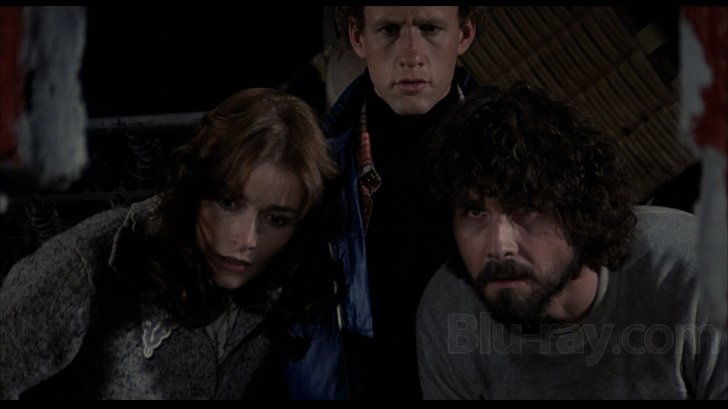
The film's best scenes occur near the beginning. In the opening, claps of thunder alternate with shotgun blasts as an entire family is murdered in a house in Amityville, Long Island, during a torrential downpour. A year later, a real estate broker, Mrs. Townsend (Ida Straus, the clock tower lady in Back to the Future), is showing the empty home to George and Kathy Lutz (James Brolin, mountain-man hairy, and Margot Kidder, dressed like a Catholic schoolgirl). The Lutzes are newlyweds, but it's Kathy's second marriage, and she has three kids. The absence of the children's father is never explained; indeed, he's never even mentioned. The house is being offered at a huge discount because of its gruesome history. As Mrs. Townsend gives George and Kathy the tour, their scenes are intercut with abrupt and unsettling flashbacks to the night of the murders. If the entire film had been conceived and executed with the same degree of insight and craft, it could have been a classic. Unfortunately, all cinematic inspiration ends when the Lutzes tell Mrs. Townsend they'll take the place. From that point, the film proceeds on two neighboring tracks that go nowhere and barely intersect. In one plot line, the Lutz family tries to adapt to their new life, as strange and uncanny incidents multiply. Cold spots, odd noises, doors that open and close on their own, windows that slam shut on hands (but without breaking bones), important objects that suddenly vanish and ghostly apparitions are among the indicators of a haunting. Amy, Kathy Lutz's daughter and youngest child, suddenly acquires a new "imaginary" friend, who appears to have malevolent intentions. Among other things, she manages to imprison a terrified baby-sitter (Amy Wright) in a closet with no lock on the door. The strain takes its toll on George, or maybe it's the financial commitment. Either way, he looks awful, and he neglects his struggling business (he's a land surveyor) to the point where his partner, Jeff (Michael Sacks), drives out to Amityville with his wife, Carolyn (Helen Shaver), to see what's going on. Carolyn, who is apparently psychic, is immediately terrified when she approaches the house. But eventually Jeff persuades her to accompany him and the Lutzes inside, where her instincts lead her to the same wall in the basement where the family dog has been whining and pawing at the base. George hammers through, and they find a "red wall" that reflects George's face back to them. Carolyn suddenly suffers a seizure or a possession, while a strange voice issues from her declaring that they need to cover the gateway to hell. And with that, Jeff and Carolyn disappear from both the scene and the movie, never to be glimpsed, heard from or mentioned again. (Maybe they joined Kathy's ex-husband.) Meanwhile, George and Kathy continue living in the house with Kathy's three children, because . . . well, just because. Such is the casual indifference toward coherent storytelling with which The Amityville Horror was constructed that scenes like the "red wall" happen, but the follow-up makes no sense. The "true life" element requires that the entire family survive and flee the house at the end. Everything in between is marking time. That includes the film's second plot line. Intercut with the misadventures of the Lutz family is the fretful tale of Father Delaney (Rod Steiger), Kathy's long-time priest. Knowing the house's history, Kathy asked Father Delaney to stop by and bless their home on move-in day, and the good father actually did so. But he arrived at just the right moment when every family member happened to be out boating, so that the house's evil forces could mobilize against the devout priest without any witnesses. As he tries to perform a blessing, Father Delaney is attacked by a huge swarm of flies, suffers cramp and nausea, and hears a disembodied voice ordering him to "get out!" Back at his church, he's afflicted by boils and a fever leaving him bedridden. Indeed, the house afflicts any servant of the church who enters, as demonstrated when Kathy's aunt, a nun (Irene Dailey), tries to visit.

The Amityville Horror Blu-ray Movie, Video Quality 
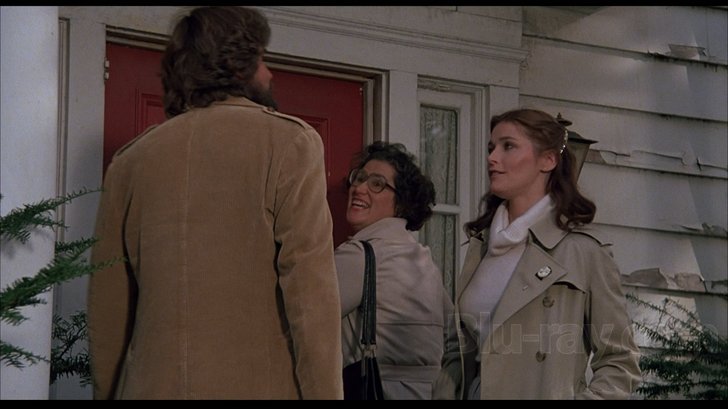
Whatever one's opinion of the film, there is nothing to fault with the Blu-ray presentation of The Amityville Horror, which doesn't necessarily mean every viewer will like it. What you get on the 1080p, AVC-encoded disc is an image much like you'd expect to see if you went to a movie theater in 1979 to catch the latest release from American International Pictures, which was one of the leading independent producers of the era. You didn't expect glossy, super-sharp images from A.I.P., and you rarely got them. The Blu-ray's image is moderately grainy, but the grain looks natural, neither artificially reduced nor digitally manipulated into odd patterns that "hang" or "clump". Detail is sufficiently well-reproduced that you can always make out the fine patterns of the terrible Seventies fashions and, in too many instances, the unconvincing makeup on James Brolin and Rod Steiger. Colors are natural-looking, though somewhat on the pale side. Black levels are generally good, though night scenes and dark interiors sometimes look more gray than black, a phenomenon I attribute more to the original photography than to "crushing". Compression artifacts were non-existent, as this is fairly undemanding material.
The Amityville Horror Blu-ray Movie, Audio Quality 
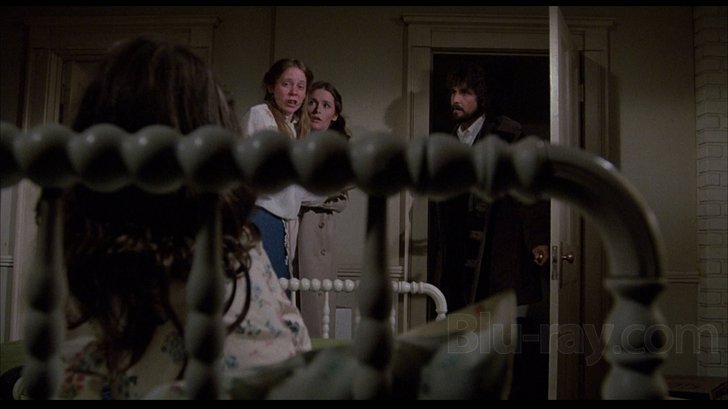
The 5.1 remix, presented in DTS lossless, of the original mono soundtrack aggressively moves specific sounds into the surround field and is surprisingly effective. Examples include the sound of George Lutz chopping wood, the family dog barking, and various slamming doors. (It's the isolation of these sounds that gives them such impact.) Major sound sequences like the opening storm take full advantage of the multi-channel system to register their presence, while dialogue remains anchored to the front (most of the time) and always clear. Bass extension is relatively modest, which is undoubtedly a limitation of the source material. Lalo Schrifin's original score supplies as much atmosphere as it can.
The Amityville Horror Blu-ray Movie, Special Features and Extras 
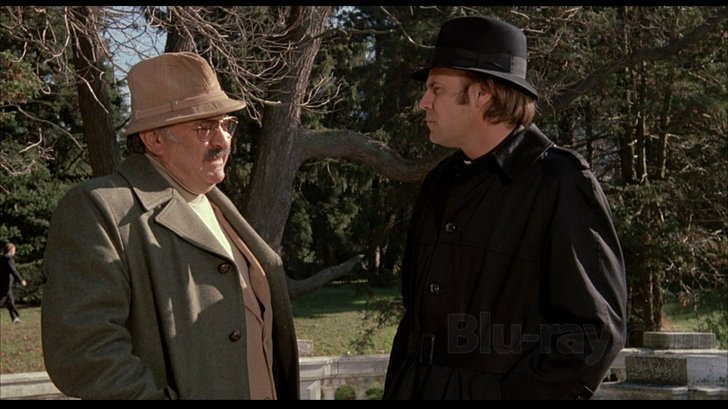
Is this a menu I see before me, the cursor toward my hand? Back in 2008, when Fox issued The Amityville Horror for MGM on Blu-ray, it included a menu and allowed the user to resume playback from the same point after stopping. The reissue due on Sept. 13, 2011 is expected to be the same disc. Consider it a relic of a bygone day, before Fox decided to make MGM Blu-rays less user-friendly.
- Theatrical Trailer (HD; 1.85:1 2:29): It has wonderfully portentous narration and makes the film look far more coherent than it is.
- Other Trailers (HD): The Terminator (1.85:1:57) ("You're dead, honey!") and Species (2.35:1; 1:50) ("Outcome Unknown").
The Amityville Horror Blu-ray Movie, Overall Score and Recommendation 
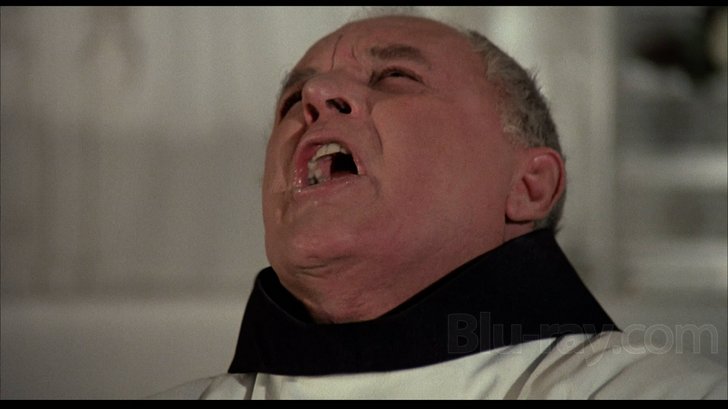
I can't recommend The Amityville Horror, because, despite the Blu-ray's technical merits, I don't think the film is worth anyone's time (except maybe as a historical artifact). However, if it ranks highly on your nostalgia scale, then I think this Blu-ray is about as good as it's going to get. I recognize that at least one user review has suggested that a future version could improve on the image, but I doubt it, unless -- and this could happen -- a new technology is created to synthesize a brand new, clean, "ideal-def" version of a movie from a film scan. If that ever happened, it would be the hi-def version of colorization, and I doubt it would be a favor to fans of Amityville. Some things are only charming because they're old. The more clearly you see this movie, the harder it'll be to overlook its considerable shortcomings.
Other editions
The Amityville Horror: Other Editions

The Amityville Horror
1979

The Amityville Horror
1979

The Amityville Horror w/ Halloween FP
1979

The Amityville Horror 4K
Limited Edition
1979

The Amityville Horror 4K
Limited Edition
1979
Similar titles
Similar titles you might also like

Amityville 3-D
1983

Amityville II: The Possession
1982

The Amityville Horror 4K
Collector's Edition
2005

Annabelle Comes Home
2019

Sinister
2012

The Grudge
Unrated
2004

The Legend of Hell House
1973

Paranormal Activity 2
Unrated Director's Cut
2010

Paranormal Activity
Theatrical + Unrated Alternate Cut
2007

The Curse of la Llorona
2019

Darkness
R-rated Extended Cut
2002

Poltergeist 4K
1982

House on Haunted Hill
Collector's Edition
1999

The Haunting
1963

V/H/S
2012

House on Haunted Hill 3D
1959

Haunter
2013

The Abandoned
Limited Edition | After Dark Horrorfest
2006

Haunting of Winchester House
2009

1408
2007